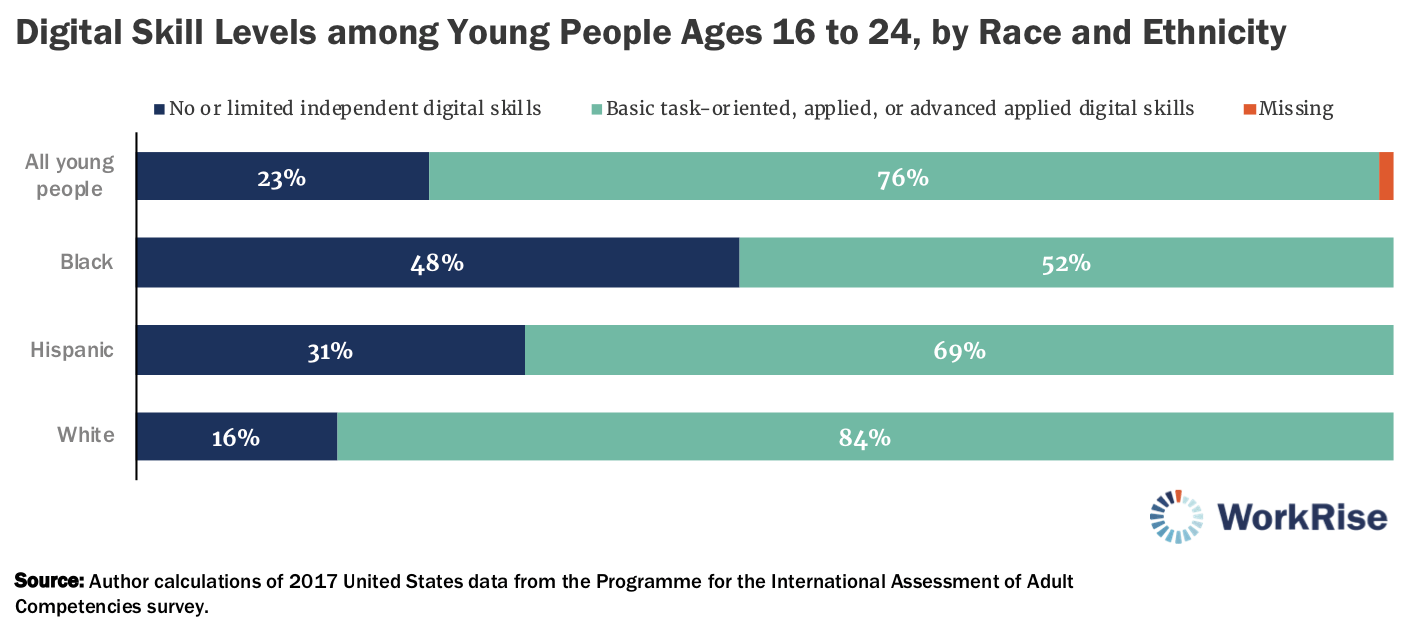Today’s labor market increasingly requires digital skills to search, apply for, and succeed in higher-wage jobs that are also associated with high degrees of digitalization. Young people ages 16 to 24 were hit hard during the COVID-19 pandemic by education and training disruptions and job losses in the retail, hospitality, and food service industries—along with the inability to work these jobs remotely. In April 2020, youth unemployment reached 27.4 percent, compared with 14.7 percent for all US workers, spotlighting the pandemic’s devastating effect on youth employment.
Existing socioeconomic and racial disparities in access, employment, and opportunity for young people that are the result of policies rooted in structural racism were also magnified during the pandemic. Intentional investments in digital access and training and effective remote service delivery will be particularly important in the pandemic’s aftermath to reconnect young people to the labor force and mitigate equity gaps that can prevent young people—especially young people of color—from accessing opportunities in an increasingly technology-dependent economy.
Many young people lacked digital skills before the pandemic
“Digital skills” refers to the ability to use digital tools, such as web browsers or email applications, to complete tasks. Although some assume young people are “digital natives” and technologically fluent, evidence suggests many younger Americans lack the digital skills required to succeed in the workforce, such as using online resources to solve a problem or assessing an online source’s relevance.
Our recent research on digital skill gaps among young people in the US ages 16 to 24 estimates digital skill levels using the 2017 Programme for the International Assessment of Adult Competencies survey and finds nearly a quarter (23 percent) of all young people in the United States have no or limited independent digital skills, ranging from a total lack of computer experience to the inability to use a generic web application, such as email.
Disparities in skill levels by race and ethnicity are stark. Black young people are three times (48 percent) as likely as white young people (16 percent) to have no or limited independent digital skills, and Hispanic young people are nearly twice as likely (31 percent) as white young people to have no or limited independent digital skills.

Although young people in the workforce have higher digital skill levels compared with all young people, differences in skill levels by race and ethnicity persist even among the employed.
Our research finds almost half (49 percent) of young white workers have applied or advanced digital skills—skills that enable the use of technology tools for inferential reasoning or to overcome challenges—compared with 17 percent of young Black workers and 32 percent of young Hispanic workers. This suggests white young people may have greater access to technology outside of school and work opportunities than other young people or a greater ability to access high-quality education and training.
These racial and ethnic gaps in digital skill attainment are concerning, given research documenting that digital skills are foundational for career advancement and that early work experiences are important indicators of long-term economic and socioemotional gains. Digital skill gaps are also exacerbated by the digital divide, with well-documented disparities in broadband internet access by race and ethnicity.
Looking forward
The COVID-19 pandemic hit teens and young adults especially hard, disrupting school and work schedules and likely exacerbating digital skill gaps. Virtual school, internships, and job hunting became the norm, and those without the skills or access to leverage these platforms have fallen further behind. Practitioners, policymakers, and researchers must learn more about what drives disparities in digital skill attainment to improve the systems of education and training that can address those gaps. Promising next steps for policy and research include:
- Expanding broadband internet access, particularly in areas of high disconnection and rural areas, where connections may be slow or nonexistent. The American Jobs Plan’s proposal to invest $100 billion in expanding broadband infrastructure could begin to address this need. A public option for broadband internet could reduce some of the strain on private providers of broadband services.
- Investing in local communities, programs, and institutions that serve young people. Libraries, nonprofits, and other education and training providers use thoughtful approaches to serve young people of color, provide them with access to technology, and embed training interventions designed to close digital literacy gaps into their programs. The bipartisan support for the upcoming reauthorization of the Workforce Innovation and Opportunity Act (WIOA) could catalyze strategies and support programs for young people, given the large share of out-of-school, out-of-work young people served through the WIOA Title I Youth program.
- Center young people’s user experience and their device access in the design of digital skills training. When considering young peoples’ needs, smartphone compatibility may be particularly important. According to 2021 survey research by the Pew Research Center, 28 percent of US adults ages 18–29 indicated they rely on smartphones for online access, compared with 11 to 13 percent in all other age groups (ages 30 and older).
- Additional research with an explicit racial equity lens can identify necessary supports for young people to successfully use digital tools in pursuing their educational and professional goals. The proposal in the American Families Plan to provide community colleges with grants to support completion and retention, including wraparound supports for student success, is one vehicle colleges could pilot to study the effectiveness of supports for successful digital skills attainment. Disaggregating outcomes data by race and ethnicity will be imperative for understanding the impacts on young people of color. From mental health to academic to career-oriented supports, there are lessons learned from the pandemicabout remote service delivery that can be leveraged by training providers, but evidence gaps about what works best for specific groups in specific contexts remain.
The current period of economic recovery is the time for education and training providers and policymakers to invest in closing digital skill gaps to help young people connect—and stay connected to—the labor market.